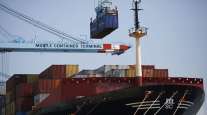Intermodal Shipments Fall 6.1% in 2Q

This story appears in the Aug. 15 print edition of Transport Topics.
Intermodal freight shipments fell 6.1% in the second quarter from a year earlier, ending a string of 25 consecutive quarterly increases, hurt by fewer international and trailer shipments, the Intermodal Association of North America reported.
Total North American intermodal loads were 4.27 million, down from 4.55 million in the second quarter of 2015. Trailer shipments fell to 291,000, a 29% decline, in part because Norfolk Southern Corp. scaled back its Triple Crown trailer freight network. Domestic container freight rose 3.4% to 1.83 million loads, but international intermodal slipped 9.3% to 2.15 million.
“The sharp decline in trailers was somewhat expected,” the IANA report said, since the Norfolk Southern action was announced in September 2015. The decline is expected to continue in the third quarter and moderate in the final three months of the year.
IANA said the decline in international business was the largest since the fourth quarter of 2009, though part of the reason may be related to port issues early in 2015 that pushed some freight into the second quarter. The trade group said the decline was “a bit confusing” since international freight trends typically correspond with global trade statistics that were more favorable than the IANA total.
The group sounded a more optimistic tone for the second half of this year, suggesting that international intermodal could grow as much as 3.3%.
“With consumer spending healthy and the dollar still highly valued, imports should strengthen in the second half,” the report said, cautioning that high inventories could hold back growth.
“Certainly, 2016 will continue to be challenging for intermodal demand. For overall loadings, there may be enough recovery in the second half to deliver an increase, albeit modest, for the full year. But looking farther ahead, the industry will continue to focus on enhanced service, expanded capacity, and new lanes and terminals,” the report said.
IANA’s report acknowledged that longhaul trucking has effectively protected market share, helped by lower diesel prices.
At the same time, the trade association noted that domestic container freight “remains the most important opportunity for railroads to replace the significant amount of other business lost over the past two years.”
A 5% to 6% year-over-year increase in domestic container cargo was projected for all of 2016, signaling an accelerated pace from the 4.4% rise in the 2016 first half.
IANA’s report also included details on trucking activity, supplied by consultant FTR.
The data for truck shipments of all distances showed a seasonally adjusted improvement in demand sequentially of 0.6% from the first to the second quarter. Year-over-year, truck freight on that basis improved 2.5% overall.
Trucking demand also increased for freight moving 550 miles or more, where intermodal competes with highway freight. The sequential increase was 0.8%. Year-over-year, the increase was 0.7%.
“The slow acceleration in demand for longhaul truck transport was certainly good news for intermodal, but projections indicate that any improvement going forward will be minimal,” IANA’s report said.
In addition to the FTR data, the report also included trends for intermodal marketing companies that arrange both truck/rail and highway freight. In the second quarter, the marketing companies’ intermodal volume fell 18% and highway shipments rose 17%.




